skip to main |
skip to sidebar
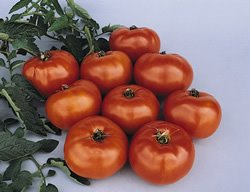 Even with optimal tomato care, the stresses of excessive summer heat and drought can make for a poor harvest.
Even with optimal tomato care, the stresses of excessive summer heat and drought can make for a poor harvest.
Next year, consider growing varieties next year that have been developed to withstand hotter conditions. Another option is to grow determinate varieties, which fruit abundantly in one flush and then die. Most varieties are indeterminate, which mean they flower, fruit and grow continuously through the season. But a determinate variety timed to fruit in late July would avoid the problems of poor flower pollination and heat stress in August.
North Carolina State University has developed several commercial varieties for hot climates that are available in some seed catalogues for consumers. This winter, look for Mountain Pride, Mountain Fresh and BHN 640, all determinate types.
Megan Gardner, a Virginia Cooperative Extension tomato specialist, also recommends a determinate plum tomato named Plum Crimson.
Jon Traunfeld, of the Maryland Home and Garden Information Center, recommends two hybrids that do well in hot climates: Celebrity, a determinate, and Big Beef, an indeterminate. And David Chambers, who manages the 7.5-acre fruit and vegetable garden at Callaway Gardens in Pine Mountain, Ga., said an indeterminate variety named Jet Star did well in this difficult year. "It seems to set fruit even when the temperatures are in that 80-degree range at night," he said.
The three experts are unanimous in urging growers to use a generous layer of mulch. Gardner said it's especially important to remove diseased leaves and not to water overhead. Diseased vines should be kept out of the compost pile, she said.
from The Washington Post
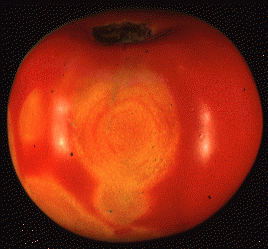 SAN JOAQUIN VALLEY - Tomato Spotted Wilt Virus (TSWV) in tomatoes has been increasing, both in the southern San Joaquin Valley as well as in San Joaquin County, according to Brenna Aegerter, vegetable farm advisor for the county. While there have been “hot spots” of high disease incidence especially down south, “the majority of fields have just a few infected plants,” according to Aegerter.
SAN JOAQUIN VALLEY - Tomato Spotted Wilt Virus (TSWV) in tomatoes has been increasing, both in the southern San Joaquin Valley as well as in San Joaquin County, according to Brenna Aegerter, vegetable farm advisor for the county. While there have been “hot spots” of high disease incidence especially down south, “the majority of fields have just a few infected plants,” according to Aegerter.
Symptoms of TSWV are bronzing of leaves followed by the development of necrotic spots and streaks on the foliage and stems, which may be followed by shoot dieback. On fruit, characteristic ringspots develop. On red fruit these can be quite striking, but they are also faintly visible on green fruit, said the veg crop farm advisor who is a specialist in plant pathology.
TSWV has an extremely wide host range, including hundreds of plants species spanning both broadleaves and monocots like as orchids and lilies.
Economic hosts in California include tomato, pepper, beans, corn, lettuce, radicchio, celery and many ornamentals.
“There are many potential weed hosts, including nightshade, purslane and pigweed. This virus is vectored by at least 10 thrips species, including the western flower thrips and the onion thrips,” said Aegerter.
After egg hatch on TSWV-infected plants, the first and second instar larvae acquire the virus. The virus reproduces within the thrips and they can then transmit the virus to healthy plants when they are adults.
“Adults cannot pick up the virus, nor can they pass the virus on to their offspring,” said the farm advisor. “Therefore, in order for a plant to be a source of the virus for new infections and spread, it must support reproduction of both the thrips and the virus.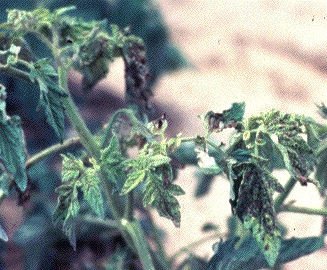
“In the past, we thought that there was no build-up or secondary spread within tomato fields because tomatoes did not support reproduction of thrips. However, observations this season of very heavily infected tomato fields adjacent to unaffected fields suggest that the vector and virus may be capable of building up within a tomato field. If this turns out to be the case, then controlling the thrips may prove beneficial in reducing the spread of the virus within a tomato field.”
Because there are so many potential sources of inoculum and because their contribution to the problem may change from year to year, there is no clear strategy for positioning tomato crops to avoid infection, according to Aegerter.
Resistant varieties have been developed for both processing and fresh market varieties and these are currently being evaluated.
“Unfortunately, where resistance to TSWV has been introduced into other crops, the resistance has nearly always been overcome by the rapid occurrence of resistance-breaking strains of the virus,” said the farm advisor.
The geographic distribution of the problem (increasing southward in the Central Valley) may reflect the effect of winter temperatures on survival of the vectors. Colder winter temperatures may limit the overwintering of the western flower thrips in the Sacramento Valley. Its development does not progress at below 49 degrees. Higher disease incidence in the San Joaquin Valley might also be due to winter vector host crops such as lettuce and radicchio. The overlap of winter and summer host crops may provide a year-round habitat for the virus and its vector, said the farm advisor.
The disease could be spreading due to mildew winters of late.
Plant pathologists from UC Davis are currently studying the outbreaks in tomatoes in conjunction with Cooperative Extension Farm Advisors who are looking for fields with high incidents of wilt.
“Hopefully we will soon have a better grasp on what factors increase the risk of significant infection,” said the farm advisor.
from Western Farm Press
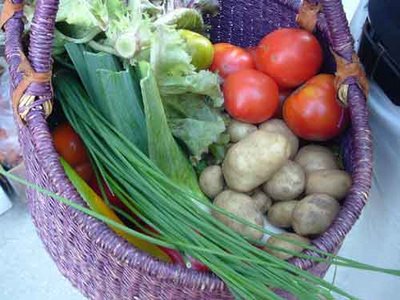 MINNEAPOLIS/ST. PAUL, MINNESOTA - If you love fresh produce, but are sick of running to the store to stock up, there's another way to make a real investment in healthy eating.
MINNEAPOLIS/ST. PAUL, MINNESOTA - If you love fresh produce, but are sick of running to the store to stock up, there's another way to make a real investment in healthy eating.
Lisa Oram loves to cook with fresh vegetables, so to keep in piles of produce at reasonable prices, she decided to skip the store and invest in a local farm.
"We get better stuff than we get at the grocery store," Oram said.
She is no farmer, but she is part of what's called a CSA or a Community Supported Agriculture farm. It is becoming a food phenomenon.
"There's about 3,000 of these farms that are doing it," said Dan Kaplan, a CSA farm manager.
Before growing season starts, members buy a share of the upcoming crop at an average cost of about $400. Then throughout the season, members receive a set amount of whatever is being harvested.
"That share roughly feeds a family with two adults and however many kids are there," Kaplan said.
If members live in a city or suburb, many farms offer drop off locations. Oram drives to her CSA and said there is no doubt she is saving money.
"I'm sure if we went to the grocery store to buy organic produce, which is what we're getting at the, at the farm, we would spend a lot more than we do in one season's share," Oram said.
Research backs that up. A study found savings of between 60 and 150 percent over retail prices for the same amount of organic produce.
But there are things to consider. Kaplan said, like with any investment, there are no guarantees.
"Shareholders buy into the risk and to the reward of farming so if there's a bad crop, we all share that loss and if there's a bounty, we all share that excess," Kaplan said.
There can be excess. A share typically amounts to between 300 and 500 pounds of produce per season.
Oram is trying a half a share and said her family is hooked.
"The produce and the value is definitely the top benefit but the other benefit is there is a community," Oram said.
Most of the farms consider their crops organic. Some are certified organic but others are not.
from WCCO / CBS
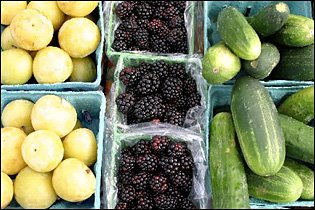 MISSOURI - Meander through a farmers market, and you may notice your thoughts about fruits and vegetables evolving. Garlic scapes, 30 varieties of apples, white peaches, salmon-colored raspberries, 14 varieties of beans, six varieties of corn. ... Over the course of the growing season, you'll see these and more.
MISSOURI - Meander through a farmers market, and you may notice your thoughts about fruits and vegetables evolving. Garlic scapes, 30 varieties of apples, white peaches, salmon-colored raspberries, 14 varieties of beans, six varieties of corn. ... Over the course of the growing season, you'll see these and more.
When you buy directly from farmers, what you won't find is out-of-season produce -- no apples in early May, no asparagus in October. Storage and shipping innovations have made most of what we eat seem seasonless, but when you buy locally grown fruits and vegetables, you'll taste the difference.
"So many people are used to opening up a cookbook, looking at a pretty picture and deciding to create a meal without really thinking about whether or not the ingredients are in season at that time," says Peggy Knickerbocker, co-author of "The San Francisco Ferry Plaza Farmers' Market Cookbook." Her book is a comprehensive guide to choosing, storing and preparing fruits and vegetables based on their seasonal availability.
When shoppers buy from the farmer, they know the food is at its peak, says Julie Ridlon, director of the Clayton Farmers Market.
"The produce is picked when it has the highest sugar content," usually not more than a few days before it is brought to the market, she says. "When you come to shop, it will be ripe."
Some markets include produce vendors, who buy from middlemen. Soulard Market fits that description. Market master Sandra Zak suggests walking around to explore what's being offered and at what prices. This strategy will give you time to decide what to buy, as well as give you a feel for the market's personality.
"The market is a great place to people-watch," Zak says. "Soulard, in particular, is one of the oldest and largest places in the region where people of every ethnicity, socioeconomic group and religion gather together to feed their families good, wholesome food."
That kind of community is vital, Knickerbocker says, and difficult to find.
"We don't have town squares anymore, and most of us are so busy in this day and age that we don't stop to catch up and spend time with others equally interested in eating well and supporting local agriculture," she says.
Ridlon agrees that visiting a farmers market is a sensory experience.
"It's about smells, sounds, sight, feel and taste," she says. "When you come to the market, everything is alive."
Even those who run the markets can be amazed by the wealth of local produce.
"There are things I saw at the market last year that I've never seen before, things like pineapple tomatillos and countless varieties of squash in all shapes and sizes," says Julia Feder, market master of the Central West End's Green Market.
"We've easily got 20 different varieties of peppers, many of which most people have probably never seen before," she says. "The grocery store only offers the basics, but at the market it's all about variety. Trying something new and different each week is truly a joy."
When in doubt about the produce on display, just ask a farmer.
"The person selling you the produce is the best expert you can get," Feder says. "I encourage people to get to know the farmers and ask them tons of questions. They want you to be as satisfied as possible with their products."
from St. Louis Today
 Even with optimal tomato care, the stresses of excessive summer heat and drought can make for a poor harvest.
Even with optimal tomato care, the stresses of excessive summer heat and drought can make for a poor harvest.


